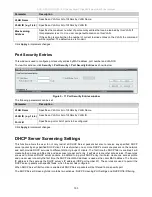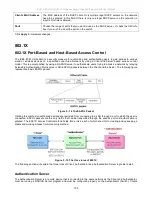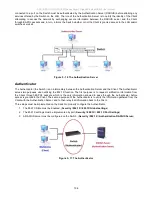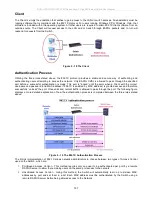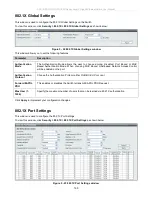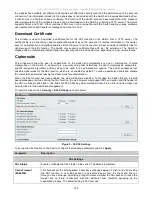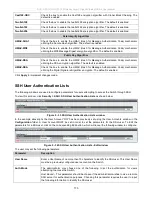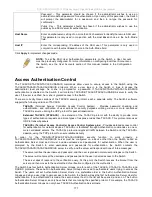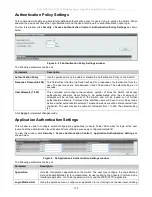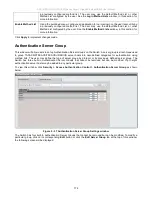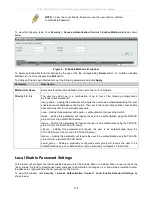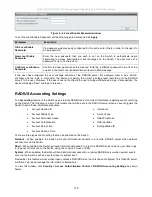
DGS-3700-12/DGS-3700-12G Series Layer 2 Gigabit Ethernet Switch User Manual
165
Guest VLAN
This window is used to configure the Guest VLAN on the Switch.
To view this window, click
Security > 802.1X >
Guest VLAN
as shown below:
Figure 5 - 29 Guest VLAN window
The following fields may be modified to enable the 802.1X Guest VLAN:
Parameter Description
VLAN Name
Enter the pre-configured VLAN name to create as an 802.1X Guest VLAN.
Port List
Set the port list of ports to be enabled for the 802.1X Guest VLAN.
Click
Apply
to implement the 802.1X Guest VLAN. Once properly configured, the
Guest VLAN Name
and associated
ports will be listed in the lower part of the window.
NOTE:
For more information and configuration examples for the 802.1X Guest VLAN
function, please refer to the Guest VLAN Configuration Example located on the D-Link
website.
SSL Settings
Secure Sockets Layer or SSL is a security feature that will provide a secure communication path between a host and
client through the use of authentication, digital signatures and encryption. These security functions are implemented
through the use of a
ciphersuite
, which is a security string that determines the exact cryptographic parameters,
specific encryption algorithms and key sizes to be used for an authentication session and consists of three levels:
1.
Key Exchange:
The first part of the cyphersuite string specifies the public key algorithm to be used. This
switch utilizes the Rivest Shamir Adleman (RSA) public key algorithm and the Digital Signature Algorithm
(DSA), specified here as the
DHE DSS
Diffie-Hellman (DHE) public key algorithm. This is the first
authentication process between client and host as they “exchange keys” in looking for a match and therefore
authentication to be accepted to negotiate encryptions on the following level.
2.
Encryption:
The second part of the ciphersuite that includes the encryption used for encrypting the messages
sent between client and host. The Switch supports two types of cryptology algorithms:
•
Stream Ciphers – There are two types of stream ciphers on the Switch,
RC4 with 40-bit keys
and
RC4
with 128-bit keys
. These keys are used to encrypt messages and need to be consistent between
client and host for optimal use.
•
CBC Block Ciphers – CBC refers to Cipher Block Chaining, which means that a portion of the
previously encrypted block of encrypted text is used in the encryption of the current block. The Switch
supports the
3DES EDE
encryption code defined by the Data Encryption Standard (DES) to create
the encrypted text.
3.
Hash Algorithm
: This part of the ciphersuite allows the user to choose a message digest function which will
determine a Message Authentication Code. This Message Authentication Code will be encrypted with a sent
message to provide integrity and prevent against replay attacks. The Switch supports two hash algorithms,
MD5
(Message Digest 5) and
SHA
(Secure Hash Algorithm).
These three parameters are uniquely assembled in four choices on the Switch to create a three-layered encryption
code for secure communication between the server and the host. The user may implement any one or combination of



